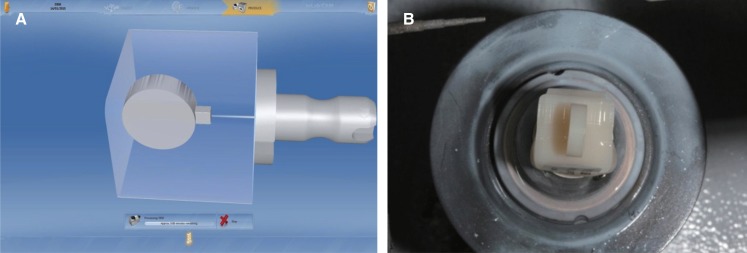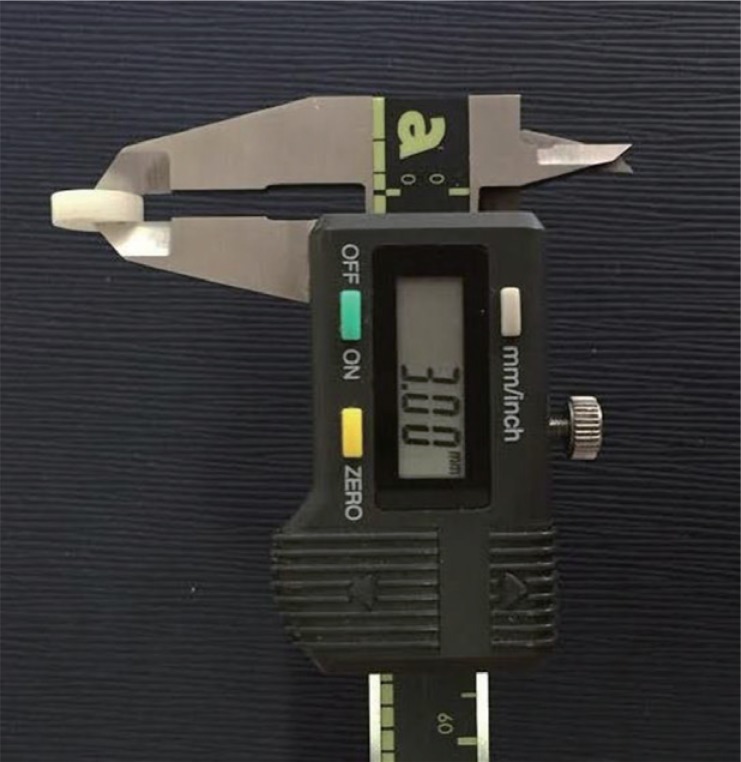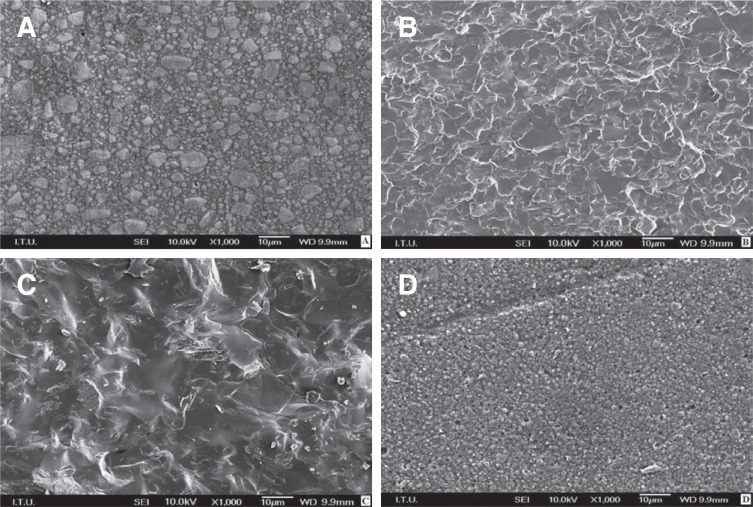J Adv Prosthodont.
2018 Aug;10(4):271-278. 10.4047/jap.2018.10.4.271.
Surface deterioration of monolithic CAD/CAM restorative materials after artificial abrasive toothbrushing
- Affiliations
-
- 1Department of Prosthodontics, School of Dentistry, Istanbul University, Istanbul, Turkey. nazmiye.sonmez@istanbul.edu.tr
- 2Department of Metallurgical and Materials Engineering, Faculty of Chemistry and Metallurgy, Istanbul Technical University, Istanbul, Turkey.
- KMID: 2418632
- DOI: http://doi.org/10.4047/jap.2018.10.4.271
Abstract
- PURPOSE
The purpose of this in vitro study was to evaluate the effect of abrasive toothbrushing on the surface properties of monolithic computer-assisted design and computer-assisted manufacturing (CAD/CAM) materials stored in food-simulating liquids (FSLs).
MATERIALS AND METHODS
Fourty-eight disk-shaped test specimens of each material (Paradigm MZ100/PMZ, Lava Ultimate/LU, Vita Enamic/VE, and Vita Mark II/VMII) with a diameter of 10.0 mm and a thickness of 3.0 ± 0.05 mm were prepared. Specimens were divided into 4 subgroups (n=12) and stored in air, distilled water, 0.02 M citric acid, or 75% ethanol/water solution for 7 days at 36.5℃. Then, the specimens were brushed in a multi-station brushing machine under a vertical load of 2.0 N for 3 hours. Surface gloss (GU), roughness (Ra), and hardness (Vickers [VHN]) were measured after storage and brushing simulation. The data sets were statistically analyzed with 2 and 3-way ANOVAs followed by the Tukey's post-hoc comparisons (α=.05).
RESULTS
Statistically significant difference was found among the materials concerning the results of surface properties. VMII showed the highest VHN, while PMZ produced the lowest. Storage in FSLs significantly affected the VHN of PMZ and LU. VMII showed the lowest Ra and highest GU irrespective of FSLs and of abrasive toothbrushing. VE, LU, and PMZ produced significant decrease in GU and increase in Ra after toothbrushing.
CONCLUSION
Surface properties of monolithic CAD/CAM restorative materials were differently affected by the storage media and abrasive toothbrushing.
Keyword
MeSH Terms
Figure
Reference
-
1. Ruse ND, Sadoun MJ. Resin-composite blocks for dental CAD/CAM applications. J Dent Res. 2014; 93:1232–1234. PMID: 25344335.
Article2. Fasbinder DJ. Materials for chairside CAD/CAM restorations. Compend Contin Educ Dent. 2010; 31:702–704. 706708–709. PMID: 21197938.3. Beuer F, Schweiger J, Edelhoff D. Digital dentistry: an overview of recent developments for CAD/CAM generated restorations. Br Dent J. 2008; 204:505–511. PMID: 18469768.
Article4. Della Bona A, Corazza PH, Zhang Y. Characterization of a polymer-infiltrated ceramic-network material. Dent Mater. 2014; 30:564–569. PMID: 24656471.
Article5. Awada A, Nathanson D. Mechanical properties of resin-ceramic CAD/CAM restorative materials. J Prosthet Dent. 2015; 114:587–593. PMID: 26141648.
Article6. Tsitrou EA, Northeast SE, van Noort R. Brittleness index of machinable dental materials and its relation to the marginal chipping factor. J Dent. 2007; 35:897–902. PMID: 17977638.
Article7. Lauvahutanon S, Takahashi H, Shiozawa M, Iwasaki N, Asakawa Y, Oki M, Finger WJ, Arksornnukit M. Mechanical properties of composite resin blocks for CAD/CAM. Dent Mater J. 2014; 33:705–710. PMID: 25273052.
Article8. Park JH, Choi YS. Microtensile bond strength and micromorphologic analysis of surface-treated resin nanoceramics. J Adv Prosthodont. 2016; 8:275–284. PMID: 27555896.
Article9. Anil N, Bolay S. Effect of toothbrushing on the material loss, roughness, and color of intrinsically and extrinsically stained porcelain used in metal-ceramic restorations: an in vitro study. Int J Prosthodont. 2002; 15:483–487. PMID: 12375465.10. Tanoue N, Matsumura H, Atsuta M. Wear and surface roughness of current prosthetic composites after toothbrush/dentifrice abrasion. J Prosthet Dent. 2000; 84:93–97. PMID: 10898845.
Article11. Yap AU, Mah MK, Lye CP, Loh PL. Influence of dietary simulating solvents on the hardness of provisional restorative materials. Dent Mater. 2004; 20:370–376. PMID: 15019452.
Article12. Yap AU, Low JS, Ong LF. Effect of food-simulating liquids on surface characteristics of composite and polyacid-modified composite restoratives. Oper Dent. 2000; 25:170–176. PMID: 11203812.13. Heintze SD, Forjanic M, Ohmiti K, Rousson V. Surface deterioration of dental materials after simulated toothbrushing in relation to brushing time and load. Dent Mater. 2010; 26:306–319. PMID: 20036418.
Article14. Garza LA, Thompson G, Cho SH, Berzins DW. Effect of toothbrushing on shade and surface roughness of extrinsically stained pressable ceramics. J Prosthet Dent. 2016; 115:489–494. PMID: 26589442.
Article15. Heintze SD, Forjanic M, Rousson V. Surface roughness and gloss of dental materials as a function of force and polishing time in vitro. Dent Mater. 2006; 22:146–165. PMID: 16084582.
Article16. Franzò D, Philpotts CJ, Cox TF, Joiner A. The effect of toothpaste concentration on enamel and dentine wear in vitro. J Dent. 2010; 38:974–979. PMID: 20736044.
Article17. Rosentritt M, Sawaljanow A, Behr M, Kolbeck C, Preis V. Effect of tooth brush abrasion and thermo-mechanical loading on direct and indirect veneer restorations. Clin Oral Investig. 2015; 19:53–60.
Article18. Jassé FF, de Campos EA, Lefever D, Di Bella E, Salomon JP, Krejci I, Ardu S. Influence of filler charge on gloss of composite materials before and after in vitro toothbrushing. J Dent. 2013; 41:e41–e44. PMID: 23649047.
Article19. ISO 11609. Dentistry-Dentifrices-Requirements, test methods and marking. Geneva; Switzerland: International Organization for Standardization;2010.20. Ardu S, Braut V, Uhac I, Benbachir N, Feilzer AJ, Krejci I. Influence of mechanical and chemical degradation on surface gloss of resin composite materials. Am J Dent. 2009; 22:264–268. PMID: 20225467.21. da Silva EM, Dória J, da Silva Jde J, Santos GV, Guimarães JG, Poskus LT. Longitudinal evaluation of simulated toothbrushing on the roughness and optical stability of microfilled, microhybrid and nanofilled resin-based composites. J Dent. 2013; 41:1081–1090. PMID: 23994711.
Article22. Mörmann WH, Stawarczyk B, Ender A, Sener B, Attin T, Mehl A. Wear characteristics of current aesthetic dental restorative CAD/CAM materials: two-body wear, gloss retention, roughness and Martens hardness. J Mech Behav Biomed Mater. 2013; 20:113–125. PMID: 23455168.
Article23. Flury S, Diebold E, Peutzfeldt A, Lussi A. Effect of artificial toothbrushing and water storage on the surface roughness and micromechanical properties of tooth-colored CAD-CAM materials. J Prosthet Dent. 2017; 117:767–774. PMID: 27836147.
Article24. Ferracane JL, Marker VA. Solvent degradation and reduced fracture toughness in aged composites. J Dent Res. 1992; 71:13–19. PMID: 1531485.
Article25. Pilliar RM, Vowles R, Williams DF. The effect of environmental aging on the fracture toughness of dental composites. J Dent Res. 1987; 66:722–726. PMID: 3475303.
Article26. Sideridou ID, Karabela MM, Vouvoudi ECh. Volumetric dimensional changes of dental light-cured dimethacrylate resins after sorption of water or ethanol. Dent Mater. 2008; 24:1131–1136. PMID: 18321567.
Article27. Yap AU, Tan SH, Wee SS, Lee CW, Lim EL, Zeng KY. Chemical degradation of composite restoratives. J Oral Rehabil. 2001; 28:1015–1021. PMID: 11722717.
Article28. Özarslan MM, Büyükkaplan UŞ, Barutcigil Ç, Arslan M, Türker N, Barutcigil K. Effects of different surface finishing procedures on the change in surface roughness and color of a polymer infiltrated ceramic network material. J Adv Prosthodont. 2016; 8:16–20. PMID: 26949483.
Article29. Volpenhein DW, Walsh ME, Dellerman PA, Burkett TA. A new method for in vitro evaluation of the interproximal penetration of manual toothbrushes. J Clin Dent. 1994; 5:27–33. PMID: 8031486.
- Full Text Links
- Actions
-
Cited
- CITED
-
- Close
- Share
- Similar articles
-
- Influence of different surface treatments on bond strength of novel CAD/CAM restorative materials to resin cement
- Fabrication of CAD-CAM complete denture using existing provisional denture and digital facebow transfer
- Fabrication of complete denture using conventional method and monolithic digital denture system: a case report
- The effect of glazing and aging on the surface properties of CAD/CAM resin blocks
- Fabrication of maxillary complete denture and mandibular implant retained overdenture using CAD-CAM system and Monolithic disc: a case report





